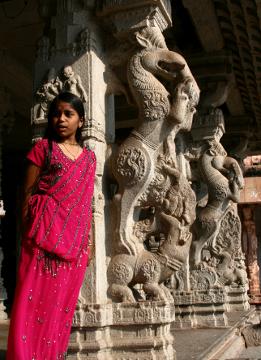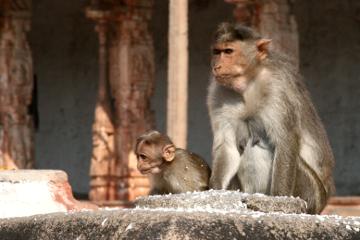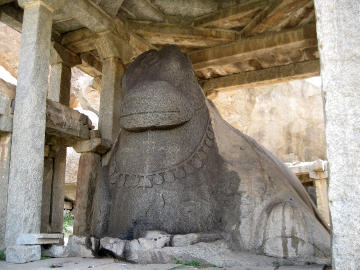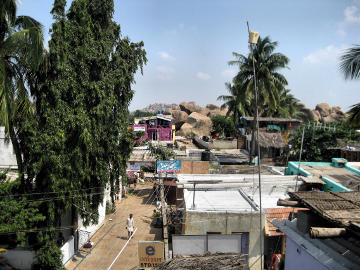Hampi/Vijayanagar (1)
Rocks and ruins
 |
This is what might be considered the iconic picture of Hampi. It was taken almost at sunset on the Tungabhadra River west of the Sacred Center, on the way to the riverside sculptures.
Picture a jumble of huge, granite boulders -- their color changing with the light -- strewn randomly about the landscape so that the piles seem to lean precariously on each other, and with a river running through them.
Next, imagine a huge, absolutely enormous, ancient city, the capital of an empire, with majestic buildings, impregnable forts and magnificent temples, but all now largely destroyed and left to erosion by wind and water -- and destruction wreaked by impoverished men seeking to take shelter in the shadow of the ruins.
Now picture the ruins scattered among the rocks and along the river, looking for all the world like they just grew up there. That is Hampi!
It would be wonderful just hiking through the scenery, being swallowed up by the shapes and colors of the rocks. It would also be wonderful wandering among the ruins, awed by the intense and unsettling presence of the shades of the creators of this ruined splendor. Experiencing both at once is almost too much. But that is India!
Hampi Bazaar, Sacred Center and Hemakuta Hill
Hampi village is on the site of the former Vijayanagara, capital of the Vijayanagar Empire (1336-1646), which covered most of southern India. The city covers an area of about 40 sq. km. With its astounding landscape and incredible monuments, it well deserves its status as a UNESCO World Heritage Site. In fact, it would be a major tourist site if it were more accessible. In our opinion, it may be a good thing that it is not.
The village of Hampi, a collection of shops, guest houses and restaurants set along narrow lanes, clusters north and northeast of the Virupaksha Temple, a functioning Hindu temple, and south of the Tungabhadra River. The street known as Hampi Bazaar stretches eastwards from the temple gopuram in a straight line about a kilometer long to the ruins near Matanga Hill at the other end. The entire length of the street is bordered on both sides by ruined buildings and galleries, of which mostly only pillars remain, many of which are now occupied by the people of Hampi as shops and homes. South of the temple rises Hemakuta Hill, a huge, sloping rock on which are still to be found Vijayanagara buildings in good shape. It is also a convenient place for observing the sunrise and sunset. All this area is known as the Sacred Center.
John can never sleep well with the excitement of knowing there is an astounding new place waiting to be explored just a hundred meters away. So, the first morning, he got up to go look at dawn on Hemakuta Hill.

|
 |
| Virupaksha Temple from Hemakuta Hill in early morning light | Ganesh Temple at sunrise |
 |
 |
| Tungabadhra rocks in morning sun | Ruined temple with Nandi on the river |
 |
 |
| Ghats of the Tungabhadra River shortly after sunrise |
Playing in the water |
Afterwards, he walked down to the Tungabhadra ghats and then witnessed an early wedding being celebrated in Virupaksha Temple.
 |
 |
|
| Vijayanagar columns in Virupaksha Temple |
Ready for the marriage |
|
 |
 |
|
| Interior court of Virupaksha Temple |
Marriage ceremony in Virupaksha Temple |
|
 |
 |
|
| Observers of the wedding |
Temple seen from rooftop restaurant |
Then Siv and John both enjoyed breakfast on the roof of their guest house (Gopi Guest House) before setting out again to see the town and Hemakuta Hill -- after a walk to register at the police station at the other end of Hampi Bazaar.

|

|
| Virupaksha Temple from Hampi Bazaar | Hampi Bazaar - old building re-used |

|

|
| Daily life in Hampi Bazaar | View back down Hampi Bazaar |

|

|
| End of Hampi Bazaar | Nandi |

|

|
| Hemakuta Hill is a huge sloping rock face | Shady spot on Hemakuta Hill |

|

|
| Monuments on Hemakuta Hill | |

|

|
| Hemakuta Hill | Hampi town - street runs right up to the rocks |
See all our Hampi pages:
- Hampi Bazaar, Sacred Center and Hemakuta Hill
- Tungabhadra riverside temples and sculptures
- Vitthala Temple
- A coracle on the Tungabhadra
- The Royal Centre
Back to India 2009.